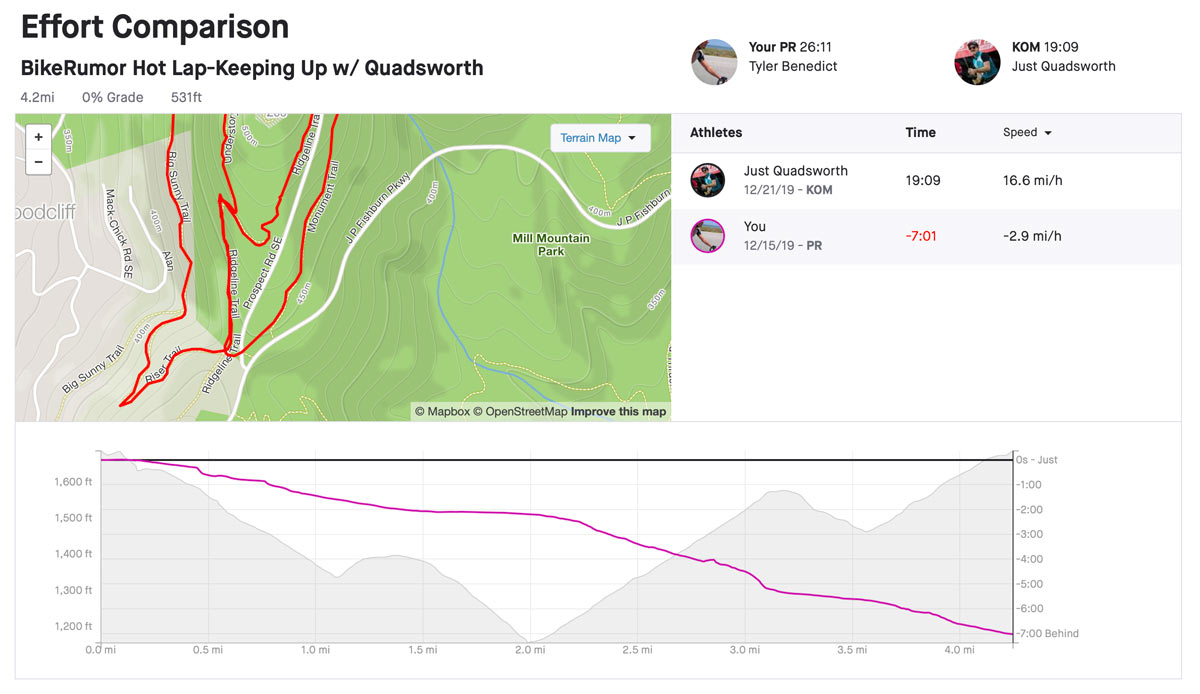Ever wonder what it’s like to race against the pros? We did, and for our second installment of Bikerumor’s Keeping up with… series, Tyler faces off against Pivot pro Gordon “Quadsworth” Wadsworth. The idea came about when we learned of the new Pivot LES Singlespeed. I’ve never ridden a singlespeed, so what better way to learn than have a pro teach me all his secrets. Then, naturally, I’d want to race him, right? Here’s how it went…
What is Singlespeed Math? What’s the ideal gear ratio?
That was one of the bigger topics Gordon and I discussed, and we geeked out super hard for longer than what you see in the race video. So I put that full conversation into a separate video (below), and created this recap. My most important takeaway? I need bigger quads!
Basically, the “taller” the gear, the harder it’s going to be to pedal, but the farther you’ll go per pedal stroke. Depending on your cadence, strength and tire size, you can use math to figure out how fast you’ll be able to travel at a given cadence. Here’s the quick math you need to know:
- Gear Ratio = Chainring ÷ Cog
- Gear Inches = Ratio x Tire Diameter
- Distance traveled / crank revolution = Gear Ratio x Tire Circumference
Circumference is (Tire Diameter x π), and π=3.1428. For the rest, check out the free gear calculator apps (iOS / Android) to do the heavy lifting. Here’s how our bikes compared:
| CHAINRING | COG | RATIO | GEAR INCHES | DIST/REV* | |
| TYLER’S BIKE | 32 | 18 | 1.78 | 51.51 | 161.74″ |
| GORDON’S BIKE | 34 | 20 | 1.70 | 49.26 | 154.68″ |
*assumes a 29×2.25″ rear tire on both bikes
With these setups, if I could maintain the same cadence as Gordon, I’d slowly walk away from him and win. But as soon as you change tire size or any other variable, you’ve got to recalculate.
#NerdAlert – Gordon goes deep into his setup, explaining how and why he chooses the gear combos he does. There’s a lot of “science” behind the decision making. He considers who his competition is, their average speed at past events, elevation profiles, and more. Then he can figure out what his speed will be at a given cadence by factoring gear ratio, tire size and gear inches. But it’s better to hear him tell it…
OK, but how do I RIDE a singlespeed bike?
Here’s where the nuance really comes in. It’s all about maintaining momentum and staying “on top of the gear”. Anytime you lose speed, you’ve got to muscle your way back up to speed. But if you can keep your cadence in your sweet spot, it’ll feel (and be) faster and smoother without draining your energy. So, ripping through corners faster, pumping the bike over the little stuff, and charging up the hills all add up to faster lap times.
My takeaway? Strength and aerobic capacity matter…and you need both. Don’t skip leg day. Because 15% bigger quads translated into a more than 25% faster lap time. It’s science.
Here’s how our race went:
Note the continually sloping time loss as Gordon pulls away from me. I chalk up the downhill’s progress to local knowledge, these are his home trails after all. But the climbs is where he really starts putting a hurtin’ on me.
Want more?
Check out our race against GU/Niner pro gravel racer Yuri Hauswald here. And let us know in the comments…who should we race next?
Full Disclosure: Pivot Cycles covered travel and production costs for us to make this video. Huge thanks to Gordon for spending the day with us, and to his friend Stratton at Starlight Apparel for the filming assist!

